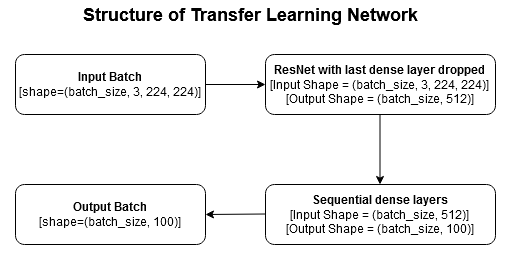CIFAR100 dataset is used here. This dataset contains 60,000 images of 100 different classes of objects with corresponding labels, where 50,000 images are for training and 10,000 are for testing. Here, 50,000 training images are splied into 45,000 actual training images and 5,000 validation images.
Images have been resized to (224 x 224) for Transfer Learning Network. Images have been normalized using torchvision.transforms.Normalize with different mean and std for Normal CNN Network input and Transfer Learning Network input.
# For Normal CNN Network
mean = [0.5071, 0.4867, 0.4408], std = [0.2675, 0.2565, 0.2761]
# For Transfer Learning Network
mean = [0.485, 0.456, 0.406], std = [0.229, 0.224, 0.225]Input shape of manually built CNN network is [batch_size, 3, 32, 32] and output shape is [batch_size, 100].
Model summary,
----------------------------------------------------------------
Layer (type) Output Shape Param #
================================================================
Conv2d-1 [200, 16, 32, 32] 448
ReLU-2 [200, 16, 32, 32] 0
BatchNorm2d-3 [200, 16, 32, 32] 32
MaxPool2d-4 [200, 16, 16, 16] 0
Conv2d-5 [200, 32, 16, 16] 4,640
ReLU-6 [200, 32, 16, 16] 0
BatchNorm2d-7 [200, 32, 16, 16] 64
MaxPool2d-8 [200, 32, 8, 8] 0
Conv2d-9 [200, 64, 8, 8] 18,496
ReLU-10 [200, 64, 8, 8] 0
BatchNorm2d-11 [200, 64, 8, 8] 128
MaxPool2d-12 [200, 64, 4, 4] 0
Conv2d-13 [200, 128, 4, 4] 73,856
ReLU-14 [200, 128, 4, 4] 0
BatchNorm2d-15 [200, 128, 4, 4] 256
MaxPool2d-16 [200, 128, 2, 2] 0
Conv2d-17 [200, 512, 2, 2] 590,336
ReLU-18 [200, 512, 2, 2] 0
BatchNorm2d-19 [200, 512, 2, 2] 1,024
MaxPool2d-20 [200, 512, 1, 1] 0
Flatten-21 [200, 512] 0
Linear-22 [200, 256] 131,328
ReLU-23 [200, 256] 0
Linear-24 [200, 100] 25,700
================================================================
Total params: 846,308
Trainable params: 846,308
Non-trainable params: 0
----------------------------------------------------------------
Input size (MB): 2.34
Forward/backward pass size (MB): 164.22
Params size (MB): 3.23
Estimated Total Size (MB): 169.79
----------------------------------------------------------------
This model took 89.83s seconds to train for 10 epochs. After training it has achived,
| ---- | Loss | Accuracy |
|---|---|---|
| Train | 2.0009 | 0.4813 |
| Validation | 2.5038 | 0.3629 |
| Test | 2.5027 | 0.3611 |
Here is it's Loss-Accuracy Plots,
Last dense layer of ResNet18 pretrained model in replaced with nn.Identity layer. So, the output dimmension became [batch_size, 512].
A sequential layer of two dense layers have been attached after that. It's structure is,
# sequential layer
nn.Sequential(
nn.Linear(in_features=512, out_features=256),
nn.ReLU(inplace=True),
nn.Linear(in_features=256, out_features=100),
)So overall output dimmension becomes [batch_size, 100].
Here is how our batch of input data passes through this model,
Model summary,
(Only number of parameters and trainable parameters are written here. Look at the notobook for more info.)
Total params: 11,333,540
Trainable params: 157,028
Non-trainable params: 11,176,512
---------------------------------------------
Input size (MB): 114.84
Forward/backward pass size (MB): 12559.53
Params size (MB): 43.23
Estimated Total Size (MB): 12717.61
---------------------------------------------
This model took 745.74s seconds to train for 10 epochs. After training it has achived,
| ---- | Loss | Accuracy |
|---|---|---|
| Train | 2.1418 | 0.4744 |
| Validation | 2.1291 | 0.4737 |
| Test | 2.1266 | 0.4734 |
Here is it's Loss-Accuracy Plots,
-
Validation and tesing accuracies of Transfer Learning Network is more than Normal CNN Network.
-
Transfer Learning Network took more time to train than Normal CNN Network for same number of epochs.
-
After letting a Normal CNN Network train to achieve maximum Transfer Learning Network validation accuracy (which is
0.4737in this case), it has stopped after17epochs, as there was no validation accuracy improvement for5consecutive epochs. It has achieved best validation accuracy of0.3629which is still less than Transfer Learning Network's best validation accuracy. Here is it's Loss-Accuracy table and plots,---- Loss Accuracy Train 1.001 0.7227 Validation 2.6721 0.3629 Test 2.6038 0.3712



